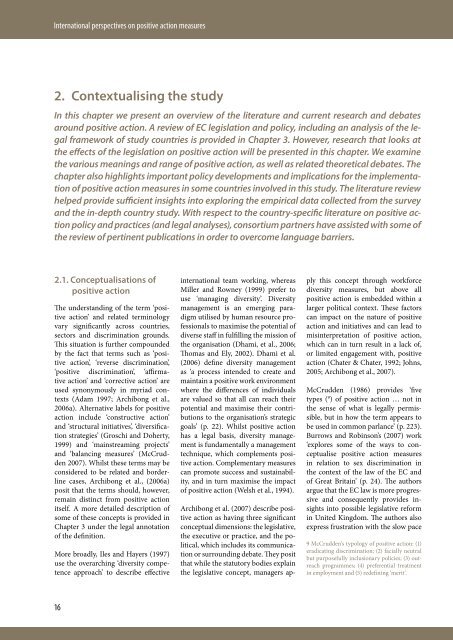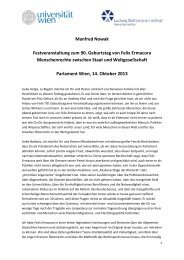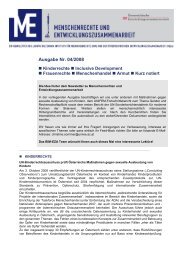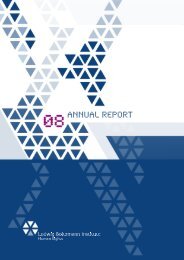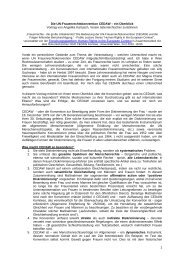International perspectives on positive action measures - European ...
International perspectives on positive action measures - European ...
International perspectives on positive action measures - European ...
You also want an ePaper? Increase the reach of your titles
YUMPU automatically turns print PDFs into web optimized ePapers that Google loves.
<str<strong>on</strong>g>Internati<strong>on</strong>al</str<strong>on</strong>g> <str<strong>on</strong>g>perspectives</str<strong>on</strong>g> <strong>on</strong> <strong>positive</strong> acti<strong>on</strong> <strong>measures</strong><br />
2.<br />
C<strong>on</strong>textualising the study<br />
In this chapter we present an overview of the literature and current research and debates<br />
around <strong>positive</strong> acti<strong>on</strong>. A review of EC legislati<strong>on</strong> and policy, including an analysis of the legal<br />
framework of study countries is provided in Chapter 3. However, research that looks at<br />
the effects of the legislati<strong>on</strong> <strong>on</strong> <strong>positive</strong> acti<strong>on</strong> will be presented in this chapter. We examine<br />
the various meanings and range of <strong>positive</strong> acti<strong>on</strong>, as well as related theoretical debates. The<br />
chapter also highlights important policy developments and implicati<strong>on</strong>s for the implementati<strong>on</strong><br />
of <strong>positive</strong> acti<strong>on</strong> <strong>measures</strong> in some countries involved in this study. The literature review<br />
helped provide sufficient insights into exploring the empirical data collected from the survey<br />
and the in-depth country study. With respect to the country-specific literature <strong>on</strong> <strong>positive</strong> acti<strong>on</strong><br />
policy and practices (and legal analyses), c<strong>on</strong>sortium partners have assisted with some of<br />
the review of pertinent publicati<strong>on</strong>s in order to overcome language barriers.<br />
2.1. C<strong>on</strong>ceptualisati<strong>on</strong>s of<br />
<strong>positive</strong> acti<strong>on</strong><br />
The understanding of the term ‘<strong>positive</strong><br />
acti<strong>on</strong>’ and related terminology<br />
vary significantly across countries,<br />
sectors and discriminati<strong>on</strong> grounds.<br />
This situati<strong>on</strong> is further compounded<br />
by the fact that terms such as ‘<strong>positive</strong><br />
acti<strong>on</strong>’, ‘reverse discriminati<strong>on</strong>’,<br />
‘<strong>positive</strong> discriminati<strong>on</strong>’, ‘affirmative<br />
acti<strong>on</strong>’ and ‘corrective acti<strong>on</strong>’ are<br />
used syn<strong>on</strong>ymously in myriad c<strong>on</strong>texts<br />
(Adam 1997; Archib<strong>on</strong>g et al.,<br />
2006a). Alternative labels for <strong>positive</strong><br />
acti<strong>on</strong> include ‘c<strong>on</strong>structive acti<strong>on</strong>’<br />
and ‘structural initiatives’, ‘diversificati<strong>on</strong><br />
strategies’ (Groschi and Doherty,<br />
1999) and ‘mainstreaming projects’<br />
and ‘balancing <strong>measures</strong>’ (McCrudden<br />
2007). Whilst these terms may be<br />
c<strong>on</strong>sidered to be related and borderline<br />
cases, Archib<strong>on</strong>g et al., (2006a)<br />
posit that the terms should, however,<br />
remain distinct from <strong>positive</strong> acti<strong>on</strong><br />
itself. A more detailed descripti<strong>on</strong> of<br />
some of these c<strong>on</strong>cepts is provided in<br />
Chapter 3 under the legal annotati<strong>on</strong><br />
of the definiti<strong>on</strong>.<br />
More broadly, Iles and Hayers (1997)<br />
use the overarching ‘diversity competence<br />
approach’ to describe effective<br />
16<br />
internati<strong>on</strong>al team working, whereas<br />
Miller and Rowney (1999) prefer to<br />
use ‘managing diversity’. Diversity<br />
management is an emerging paradigm<br />
utilised by human resource professi<strong>on</strong>als<br />
to maximise the potential of<br />
diverse staff in fulfilling the missi<strong>on</strong> of<br />
the organisati<strong>on</strong> (Dhami, et al., 2006;<br />
Thomas and Ely, 2002). Dhami et al.<br />
(2006) define diversity management<br />
as ‘a process intended to create and<br />
maintain a <strong>positive</strong> work envir<strong>on</strong>ment<br />
where the differences of individuals<br />
are valued so that all can reach their<br />
potential and maximise their c<strong>on</strong>tributi<strong>on</strong>s<br />
to the organisati<strong>on</strong>’s strategic<br />
goals’ (p. 22). Whilst <strong>positive</strong> acti<strong>on</strong><br />
has a legal basis, diversity management<br />
is fundamentally a management<br />
technique, which complements <strong>positive</strong><br />
acti<strong>on</strong>. Complementary <strong>measures</strong><br />
can promote success and sustainability,<br />
and in turn maximise the impact<br />
of <strong>positive</strong> acti<strong>on</strong> (Welsh et al., 1994).<br />
Archib<strong>on</strong>g et al. (2007) describe <strong>positive</strong><br />
acti<strong>on</strong> as having three significant<br />
c<strong>on</strong>ceptual dimensi<strong>on</strong>s: the legislative,<br />
the executive or practice, and the political,<br />
which includes its communicati<strong>on</strong><br />
or surrounding debate. They posit<br />
that while the statutory bodies explain<br />
the legislative c<strong>on</strong>cept, managers ap-<br />
ply this c<strong>on</strong>cept through workforce<br />
diversity <strong>measures</strong>, but above all<br />
<strong>positive</strong> acti<strong>on</strong> is embedded within a<br />
larger political c<strong>on</strong>text. These factors<br />
can impact <strong>on</strong> the nature of <strong>positive</strong><br />
acti<strong>on</strong> and initiatives and can lead to<br />
misinterpretati<strong>on</strong> of <strong>positive</strong> acti<strong>on</strong>,<br />
which can in turn result in a lack of,<br />
or limited engagement with, <strong>positive</strong><br />
acti<strong>on</strong> (Chater & Chater, 1992; Johns,<br />
2005; Archib<strong>on</strong>g et al., 2007).<br />
McCrudden (1986) provides ‘five<br />
types ( 9 ) of <strong>positive</strong> acti<strong>on</strong> … not in<br />
the sense of what is legally permissible,<br />
but in how the term appears to<br />
be used in comm<strong>on</strong> parlance’ (p. 223).<br />
Burrows and Robins<strong>on</strong>’s (2007) work<br />
‘explores some of the ways to c<strong>on</strong>ceptualise<br />
<strong>positive</strong> acti<strong>on</strong> <strong>measures</strong><br />
in relati<strong>on</strong> to sex discriminati<strong>on</strong> in<br />
the c<strong>on</strong>text of the law of the EC and<br />
of Great Britain’ (p. 24). The authors<br />
argue that the EC law is more progressive<br />
and c<strong>on</strong>sequently provides insights<br />
into possible legislative reform<br />
in United Kingdom. The authors also<br />
express frustrati<strong>on</strong> with the slow pace<br />
9 McCrudden’s typology of <strong>positive</strong> acti<strong>on</strong>: (1)<br />
eradicating discriminati<strong>on</strong>; (2) facially neutral<br />
but purposefully inclusi<strong>on</strong>ary policies; (3) outreach<br />
programmes; (4) preferential treatment<br />
in employment and (5) redefining ‘merit’.


